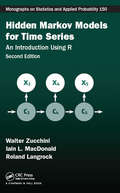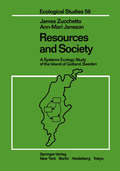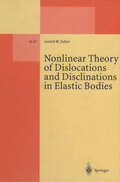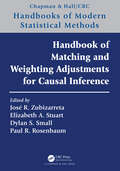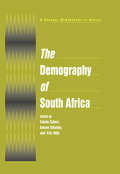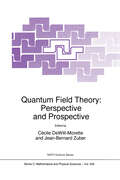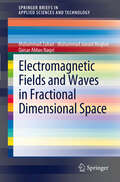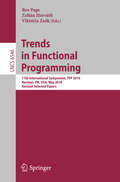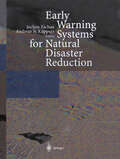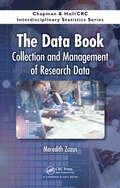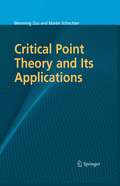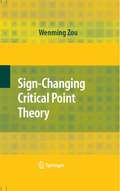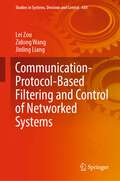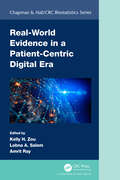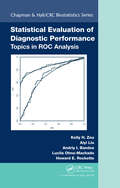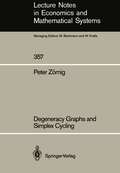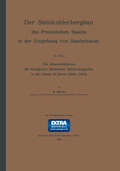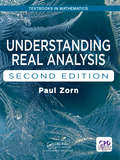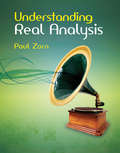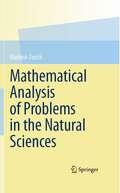- Table View
- List View
Hidden Markov Models for Time Series: An Introduction Using R, Second Edition (Chapman & Hall/CRC Monographs on Statistics and Applied Probability)
by Walter Zucchini Iain L. MacDonald Roland LangrockHidden Markov Models for Time Series: An Introduction Using R, Second Edition illustrates the great flexibility of hidden Markov models (HMMs) as general-purpose models for time series data. The book provides a broad understanding of the models and their uses. After presenting the basic model formulation, the book covers estimation, forecasting, decoding, prediction, model selection, and Bayesian inference for HMMs. Through examples and applications, the authors describe how to extend and generalize the basic model so that it can be applied in a rich variety of situations. The book demonstrates how HMMs can be applied to a wide range of types of time series: continuous-valued, circular, multivariate, binary, bounded and unbounded counts, and categorical observations. It also discusses how to employ the freely available computing environment R to carry out the computations. Features Presents an accessible overview of HMMs Explores a variety of applications in ecology, finance, epidemiology, climatology, and sociology Includes numerous theoretical and programming exercises Provides most of the analysed data sets online New to the second edition A total of five chapters on extensions, including HMMs for longitudinal data, hidden semi-Markov models and models with continuous-valued state process New case studies on animal movement, rainfall occurrence and capture-recapture data
Hidden Markov Models for Time Series: An Introduction Using R, Second Edition (Chapman & Hall/CRC Monographs on Statistics and Applied Probability #150)
by Walter Zucchini Iain L. MacDonald Roland LangrockHidden Markov Models for Time Series: An Introduction Using R, Second Edition illustrates the great flexibility of hidden Markov models (HMMs) as general-purpose models for time series data. The book provides a broad understanding of the models and their uses. After presenting the basic model formulation, the book covers estimation, forecasting, decoding, prediction, model selection, and Bayesian inference for HMMs. Through examples and applications, the authors describe how to extend and generalize the basic model so that it can be applied in a rich variety of situations. The book demonstrates how HMMs can be applied to a wide range of types of time series: continuous-valued, circular, multivariate, binary, bounded and unbounded counts, and categorical observations. It also discusses how to employ the freely available computing environment R to carry out the computations. Features Presents an accessible overview of HMMs Explores a variety of applications in ecology, finance, epidemiology, climatology, and sociology Includes numerous theoretical and programming exercises Provides most of the analysed data sets online New to the second edition A total of five chapters on extensions, including HMMs for longitudinal data, hidden semi-Markov models and models with continuous-valued state process New case studies on animal movement, rainfall occurrence and capture-recapture data
Resources and Society: A Systems Ecology Study of the Island of Gotland, Sweden (Ecological Studies #56)
by James Zucchetto Ann-Mari JanssonAlthough this book is about a specific area of the world (i.e., Gotland, Sweden), the interdisciplinary nature of the study, with regard to resources, environment, and society, makes it of interest to a number of fields. We have tried to make this book readable for a wide variety of interested parties including systems ecologists, environmental scientists, resource economists, geographers, regional planners, and regional scientists, as well as those interested in Nordic conditions. Since this project was part of UNESCO's Man and the Biosphere (MAB) pro gram, this book should be of general interest to the international community. This book is certainly not a textbook, but we see it as being useful for courses in regional analysis with plenty of examples for illustrating analysis and models related to energy, environment, and economics, or to the general field of systems ecology. An instructor could, of course, supplement the material on systems and models with other sources. We hope this small book will serve as a helpful example of the analysis of the complex interdisciplinary problems associated with resources and society. In Chapter 1, we present a brief introduction to the Gotland study as well as to some of the concepts and theories that have guided our investigations.
Nonlinear Theory of Dislocations and Disclinations in Elastic Bodies (Lecture Notes in Physics Monographs #47)
by Leonid M. ZubovThe author applies methods of nonlinear elasticity to investigate the defects in the crystal structure of solids such as dislocations and disclinations that characterize the plastic and strength properties of many materials. Contrary to the geometrically motivated nonlinear theory of dislocations continuously distributed over the body, nonlinear analysis of isolated dislocations and disclinations is less developed; it is given for the first time in this book, and in a form accessible to both students and researchers. The general theory of Volterra's dislocations in elastic media under large deformations is developed. A number of exact solutions are found. The nonlinear approach to investigating the isolated defects produces results that often differ qualitatively from those of the linear theory.
Handbook of Matching and Weighting Adjustments for Causal Inference (Chapman & Hall/CRC Handbooks of Modern Statistical Methods)
by José R. Zubizarreta Elizabeth A. Stuart Dylan S. Small Paul R. RosenbaumAn observational study infers the effects caused by a treatment, policy, program, intervention, or exposure in a context in which randomized experimentation is unethical or impractical. One task in an observational study is to adjust for visible pretreatment differences between the treated and control groups. Multivariate matching and weighting are two modern forms of adjustment. This handbook provides a comprehensive survey of the most recent methods of adjustment by matching, weighting, machine learning and their combinations. Three additional chapters introduce the steps from association to causation that follow after adjustments are complete. When used alone, matching and weighting do not use outcome information, so they are part of the design of an observational study. When used in conjunction with models for the outcome, matching and weighting may enhance the robustness of model-based adjustments. The book is for researchers in medicine, economics, public health, psychology, epidemiology, public program evaluation, and statistics who examine evidence of the effects on human beings of treatments, policies or exposures.
The Demography of South Africa
by Tukufu Zuberi Amson Sibanda Eric O. UdjoThis groundbreaking study of South Africa provides a unique look at the interplay of demographic, social and economic processes in a society undergoing rapid change as a result of the collapse of apartheid. It uses data from the first post-apartheid census as the basis for analysis of fertility, mortality within the context of HIV/AIDS, migration, education, employment, and household structure. These census data are complemented by large-scale household surveys and data from a partial registration system to study the relationships among various demographic, economic, and social phenomena. For the first time the demographic consequences of both the longer-term impact of apartheid policies and the policies of the new South Africa are examined and compared. This comprehensive reference links the demographic behavior of South Africa's various population groups to social, economic, and political inequalities created by policies of separate and unequal development. Prepared under the auspices of the Population Studies Center at the University of Pennsylvania, it is an essential resource for all scholars and practitioners in the field.
The Demography of South Africa (A\general Demography Of Africa Ser.)
by Tukufu Zuberi Amson Sibanda Eric O. UdjoThis groundbreaking study of South Africa provides a unique look at the interplay of demographic, social and economic processes in a society undergoing rapid change as a result of the collapse of apartheid. It uses data from the first post-apartheid census as the basis for analysis of fertility, mortality within the context of HIV/AIDS, migration, education, employment, and household structure. These census data are complemented by large-scale household surveys and data from a partial registration system to study the relationships among various demographic, economic, and social phenomena. For the first time the demographic consequences of both the longer-term impact of apartheid policies and the policies of the new South Africa are examined and compared. This comprehensive reference links the demographic behavior of South Africa's various population groups to social, economic, and political inequalities created by policies of separate and unequal development. Prepared under the auspices of the Population Studies Center at the University of Pennsylvania, it is an essential resource for all scholars and practitioners in the field.
Quantum Field Theory: Perspective and Prospective (Nato Science Series C: #530)
by Jean Bernard Zuber Cécile Dewitt-MoretteIt has been said that `String theorists talk to string theorists and everyone else wonders what they are saying'. This book will be a great help to those researchers who are challenged by modern quantum field theory. Quantum field theory experienced a renaissance in the late 1960s. Here, participants in the Les Houches sessions of 1970/75, now key players in quantum field theory and its many impacts, assess developments in their field of interest and provide guidance to young researchers challenged by these developments, but overwhelmed by their complexities. The book is not a textbook on string theory, rather it is a complement to Polchinski's book on string theory. It is a survey of current problems which have their origin in quantum field theory.
Electromagnetic Fields and Waves in Fractional Dimensional Space (SpringerBriefs in Applied Sciences and Technology)
by Muhammad Zubair Muhammad Junaid Mughal Qaisar Abbas NaqviThis book presents the concept of fractional dimensional space applied to the use of electromagnetic fields and waves. It provides demonstrates the advantages in studying the behavior of electromagnetic fields and waves in fractal media. The book presents novel fractional space generalization of the differential electromagnetic equations is provided as well as a new form of vector differential operators is formulated in fractional space. Using these modified vector differential operators, the classical Maxwell's electromagnetic equations are worked out. The Laplace's, Poisson's and Helmholtz's equations in fractional space are derived by using modified vector differential operators.
Trends in Functional Programming: 11th International Symposium, TFP 2010, Norman, OK, USA, May 17-19, 2010. Revised Selected Papers (Lecture Notes in Computer Science #6546)
by Viktoria Zsók Rex Page Zoltan HorvathThis book constitutes the thoroughly refereed post-conference proceedings of the 11th International Symposium on Trends in Functional Programming, TFP 2010, held in Norman, OK, USA, in May 2010. The 13 revised full papers presented were carefully reviewed and selected from 26 submissions during two rounds of reviewing and improvement. The papers cover new ideas for refactoring, managing source-code complexity, functional language implementation, graphical languages, applications of functional programming in pure mathematics, type theory, multitasking and parallel processing, distributed systems, scientific modeling, domain specific languages, hardware design, education, and testing.
Early Warning Systems for Natural Disaster Reduction
by Jochen Zschau Andreas N. KüppersWritten for a broad audience this book offers a comprehensive account of early warning systems for hydro meteorological disasters such as floods and storms, and for geological disasters such as earthquakes. One major theme is the increasingly important role in early warning systems played by the rapidly evolving fields of space and information technology. The authors, all experts in their respective fields, offer a comprehensive and in-depth insight into the current and future perspectives for early warning systems. The text is aimed at decision-makers in the political arena, scientists, engineers and those responsible for public communication and dissemination of warnings.
The Data Book: Collection and Management of Research Data (Chapman & Hall/CRC Interdisciplinary Statistics)
by Meredith ZozusThe Data Book: Collection and Management of Research Data is the first practical book written for researchers and research team members covering how to collect and manage data for research. The book covers basic types of data and fundamentals of how data grow, move and change over time. Focusing on pre-publication data collection and handling, the text illustrates use of these key concepts to match data collection and management methods to a particular study, in essence, making good decisions about data. The first section of the book defines data, introduces fundamental types of data that bear on methodology to collect and manage them, and covers data management planning and research reproducibility. The second section covers basic principles of and options for data collection and processing emphasizing error resistance and traceability. The third section focuses on managing the data collection and processing stages of research such that quality is consistent and ultimately capable of supporting conclusions drawn from data. The final section of the book covers principles of data security, sharing, and archival. This book will help graduate students and researchers systematically identify and implement appropriate data collection and handling methods.
The Data Book: Collection and Management of Research Data (Chapman & Hall/CRC Interdisciplinary Statistics)
by Meredith ZozusThe Data Book: Collection and Management of Research Data is the first practical book written for researchers and research team members covering how to collect and manage data for research. The book covers basic types of data and fundamentals of how data grow, move and change over time. Focusing on pre-publication data collection and handling, the text illustrates use of these key concepts to match data collection and management methods to a particular study, in essence, making good decisions about data. The first section of the book defines data, introduces fundamental types of data that bear on methodology to collect and manage them, and covers data management planning and research reproducibility. The second section covers basic principles of and options for data collection and processing emphasizing error resistance and traceability. The third section focuses on managing the data collection and processing stages of research such that quality is consistent and ultimately capable of supporting conclusions drawn from data. The final section of the book covers principles of data security, sharing, and archival. This book will help graduate students and researchers systematically identify and implement appropriate data collection and handling methods.
Critical Point Theory and Its Applications
by Wenming Zou Martin SchechterThis book presents some of the latest research in critical point theory, describing methods and presenting the newest applications. Coverage includes extrema, even valued functionals, weak and double linking, sign changing solutions, Morse inequalities, and cohomology groups. Applications described include Hamiltonian systems, Schrödinger equations and systems, jumping nonlinearities, elliptic equations and systems, superlinear problems and beam equations.
Sign-Changing Critical Point Theory
by Wenming ZouMany nonlinear problems in physics, engineering, biology and social sciences can be reduced to finding critical points of functionals. While minimax and Morse theories provide answers to many situations and problems on the existence of multiple critical points of a functional, they often cannot provide much-needed additional properties of these critical points. Sign-changing critical point theory has emerged as a new area of rich research on critical points of a differentiable functional with important applications to nonlinear elliptic PDEs. This book is intended for advanced graduate students and researchers involved in sign-changing critical point theory, PDEs, global analysis, and nonlinear functional analysis.
Communication-Protocol-Based Filtering and Control of Networked Systems (Studies In Systems, Decision And Control Ser. #430)
by Lei Zou Zidong Wang Jinling LiangReal-World Evidence in a Patient-Centric Digital Era (Chapman & Hall/CRC Biostatistics Series)
by Kelly H Zou Lobna A. Salem Amrit RayReal-world evidence is defined as evidence generated from real-world data outside randomized controlled trials. As scientific discoveries and methodologies continue to advance, real-world data and their companion technologies offer powerful new tools for evidence generation. Real-World Evidence in a Patient-Centric Digital Era provides perspectives, examples, and insights on the innovative application of real-world evidence to meet patient needs and improve healthcare, with a focus on the pharmaceutical industry. This book presents an overview of key analytical issues and best practices. Special attention is paid to the development, methodologies, and other salient features of the statistical and data science techniques that are customarily used to generate real-world evidence. It provides a review of key topics and emerging trends in cutting-edge data science and health innovation. Features: Provides an overview of statistical and analytic methodologies in real-world evidence to generate insights on healthcare, with a special focus on the pharmaceutical industry Examines timely topics of high relevance to industry such as bioethical considerations, regulatory standards, and compliance requirements Highlights emerging and current trends, and provides guidelines for best practices Illustrates methods through examples and use-case studies to demonstrate impact Provides guidance on software choices and digital applications for successful analytics Real-World Evidence in a Patient-Centric Digital Era will be a vital reference for medical researchers, health technology innovators, data scientists, epidemiologists, population health analysts, health economists, outcomes researchers, policymakers, and analysts in the healthcare industry.
Real-World Evidence in a Patient-Centric Digital Era (Chapman & Hall/CRC Biostatistics Series)
by Kelly H. Zou Lobna A. Salem Amrit RayReal-world evidence is defined as evidence generated from real-world data outside randomized controlled trials. As scientific discoveries and methodologies continue to advance, real-world data and their companion technologies offer powerful new tools for evidence generation. Real-World Evidence in a Patient-Centric Digital Era provides perspectives, examples, and insights on the innovative application of real-world evidence to meet patient needs and improve healthcare, with a focus on the pharmaceutical industry. This book presents an overview of key analytical issues and best practices. Special attention is paid to the development, methodologies, and other salient features of the statistical and data science techniques that are customarily used to generate real-world evidence. It provides a review of key topics and emerging trends in cutting-edge data science and health innovation. Features: Provides an overview of statistical and analytic methodologies in real-world evidence to generate insights on healthcare, with a special focus on the pharmaceutical industry Examines timely topics of high relevance to industry such as bioethical considerations, regulatory standards, and compliance requirements Highlights emerging and current trends, and provides guidelines for best practices Illustrates methods through examples and use-case studies to demonstrate impact Provides guidance on software choices and digital applications for successful analytics Real-World Evidence in a Patient-Centric Digital Era will be a vital reference for medical researchers, health technology innovators, data scientists, epidemiologists, population health analysts, health economists, outcomes researchers, policymakers, and analysts in the healthcare industry.
Statistical Evaluation of Diagnostic Performance: Topics in ROC Analysis
by Kelly H. Zou Aiyi Liu Andriy I. Bandos Lucila Ohno-Machado Howard E. RocketteStatistical evaluation of diagnostic performance in general and Receiver Operating Characteristic (ROC) analysis in particular are important for assessing the performance of medical tests and statistical classifiers, as well as for evaluating predictive models or algorithms. This book presents innovative approaches in ROC analysis, which are releva
Degeneracy Graphs and Simplex Cycling (Lecture Notes in Economics and Mathematical Systems #357)
by Peter ZörnigDie Absatzverhältnisse der Königlichen Saarbrücker Steinkohlengruben in den letzten 20 Jahren (1884–1903)
by R. ZörnerUnderstanding Real Analysis
by Paul ZornUnderstanding Real Analysis, Second Edition offers substantial coverage of foundational material and expands on the ideas of elementary calculus to develop a better understanding of crucial mathematical ideas. The text meets students at their current level and helps them develop a foundation in real analysis. The author brings definitions, proofs, examples and other mathematical tools together to show how they work to create unified theory. These helps students grasp the linguistic conventions of mathematics early in the text. The text allows the instructor to pace the course for students of different mathematical backgrounds.
Understanding Real Analysis
by Paul ZornThis book is a one-semester text for an introduction to real analysis. The author's primary aims are to develop ideas already familiar from elementary calculus in a rigorous manner and to help students deeply understand some basic but crucial mathematical ideas, and to see how definitions, proofs, examples, and other forms of mathematical "apparatu
Understanding Real Analysis
by Paul ZornUnderstanding Real Analysis, Second Edition offers substantial coverage of foundational material and expands on the ideas of elementary calculus to develop a better understanding of crucial mathematical ideas. The text meets students at their current level and helps them develop a foundation in real analysis. The author brings definitions, proofs, examples and other mathematical tools together to show how they work to create unified theory. These helps students grasp the linguistic conventions of mathematics early in the text. The text allows the instructor to pace the course for students of different mathematical backgrounds.
Mathematical Analysis of Problems in the Natural Sciences
by Vladimir ZorichBased on a two-semester course aimed at illustrating various interactions of "pure mathematics" with other sciences, such as hydrodynamics, thermodynamics, statistical physics and information theory, this text unifies three general topics of analysis and physics, which are as follows: the dimensional analysis of physical quantities, which contains various applications including Kolmogorov's model for turbulence; functions of very large number of variables and the principle of concentration along with the non-linear law of large numbers, the geometric meaning of the Gauss and Maxwell distributions, and the Kotelnikov-Shannon theorem; and, finally, classical thermodynamics and contact geometry, which covers two main principles of thermodynamics in the language of differential forms, contact distributions, the Frobenius theorem and the Carnot-Caratheodory metric. It includes problems, historical remarks, and Zorich's popular article, "Mathematics as language and method."
